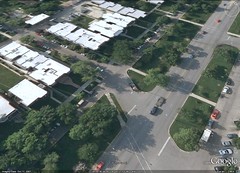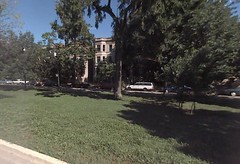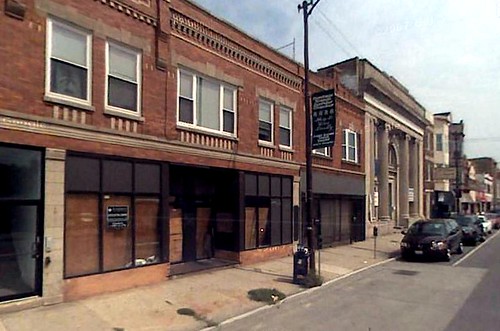'Urban farming' is not always the right answer

Posted May 20, 2010 at 1:21PM
Urban farming is all the rage, and not without reason, as more and more city dwellers are taking an interest in growing some of their own food, or at least buying as locally as possible, and as we search for creative uses for city properties not occupied by buildings. I’m on record as supporting neighborhood ‘victory gardens’ in particular, along with such initiatives as the University of Cincinnati’s small (1.24 acres) urban farm on a municipal lot in a residential portion of that city. I have also celebrated neighborhood community gardens in such residential areas as Denver's Highlands' Garden Village, Seattle's High Point, and Old North St. Louis.
But it is critical that the farming support the urban aspects of the city instead of displacing them. This means the right kind of farming (e.g., vegetables, not sheep), at the right scale (small), and in the right spots (generally residential areas where other, more traditionally urban, uses are not displaced). If we are to save the rural landscape, and the kind of rural economy that can support true family farming, we need cities to be cities, supporting compact and efficient patterns of land use and living that obviate farmland-eating sprawl.
Which brings me to a piece of vacant land near Chicago’s very urban Logan Square, a few hundred feet from a station on Chicago’s El rail transit system. The land is owned by the transit agency, because it is on top of the El where it goes underground for a bit. Before the rail-related construction, it was home to a Chinese restaurant, candy kitchen, billiard/bowling hall, bakery, drugstore, and car dealerships. In the satellite image at the top of the post, you can see the outline of the parcel to the southeast of the square, and the location of the transit station on the opposite, northwest corner of the square.
The Logan Square neighborhood has a decent amount of civic space because of the green square itself and the wide public green stretches along Logan Boulevard running east of the square (see photos) and Kedzie Boulevard running to the south. Nonetheless the transit-owned parcel was recommended by the Logan Square Open Space Plan to be committed to additional public open space, specifically a tree-lined market plaza (see plan below) that could serve as an urban gathering place as well as a spot for farmers or other vendors to offer their wares.
Since then, however, a local organization “dedicated to preserving and popularizing endangered and antique fruits” has been pushing for the space to be used for an orchard. That is a very laudable pursuit in the right places, but my friend Payton Chung, who is a thoughtful city advocate, gardener, and neighborhood resident, believes this is a space better suited to people than to specimen horticulture, especially since fruit-bearing trees would likely have to be protected from people much of the year. Payton has written an open letter to the sponsors of the orchard concept, and this is some of what he says:
“I have spent my career advocating for smart neighborhood and city planning, including longtime volunteer service on local planning in the West Town and Logan Square community areas. I also spent years as a community gardener at Greenhouse Garden in Ukrainian Village, which houses a number of espaliered heirloom fruit trees.
“When I participated in the Logan Square Open Space Plan public outreach process, the conversation about this parcel centered around creating a space filled with human activity.
That makes sense given that this is one of Logan Square’s busiest corners, with thriving businesses opening up all around. Pedestrian-oriented retail districts like this need a critical mass of activity to thrive, and that activity should be reinforced whenever possible. That the retail is growing despite nearby parking lots, blank walls, empty storefronts, and high-speed thoroughfares is heartening, but we cannot take further growth for granted. A market plaza would bring more people and more commerce to this corner, helping all of the nearby businesses thrive…
“An orchard, closed and gated to the public for all but a few days each year (I know from experience that otherwise fruit and/or trees would be lost to theft or vandalism), would do nothing to reinforce this hub of activity. Creating a “walled garden” (lasting at least several, if not a hundred, years) at the key junction of the Logan-Milwaukee business district will freeze this budding area’s growth and prevent it from coalescing into something greater.
In addition, I know from having dug in my own yard that the soil underneath this site does not lend itself to trees: construction of the subway portal and trench required extensive excavation which was backfilled with gravel aggregate, which lurks just a foot beneath the ground.
“Scores of vacant lots exist elsewhere in Logan Square, Humboldt Park, and Garfield Park, including high-visibility sites along the boulevard system or near the future Bloomingdale Trail. In fact, the Logan Square Open Space Plan identified several lots that would be ideal for community gardens, provided a group (like yours) was willing to step up and organize management of the site. Many of these would make for suitable locations for quiet agricultural uses, reinforcing the areas’ quiet residential or industrial character.
“I wish your organization luck on finding a great site for your worthy project.”
On Payton's blog, representatives of C.R.O.P., the organization sponsoring the orchard, respond (brief excerpt):
"It is important to not miss the point that the C.R.O.P. plan offers multi-use and access to that parcel of land.
The schematics show that there is a planned public access 'Plaza' [note: light blue portion in image] adjacent to the orchard. This part of the site would presumably have unlimited public access, benches, plantings for an open air plaza that fronts right onto the 'busy traffic' portion of the Logan Square.
"Meanwhile, the south east portion of the site that is more narrow and runs down Milwaukee Ave [dark blue portion], would be set aside for the protected orchard. If the plan were to be approved by the City of Chicago, they would be involved in a substantial 'remediation' of the site which would include removal of the current gravel and clay soil and replacement with an extremely deep placement of soil appropriate for growth."
Could Logan Square residents have it both ways - an educational portion of the site with a protected orchard, and a more active civic portion freely accessible to the public? The situation is intriguing precisely because it does not lend itself to easy answers.
I cannot say that I know the site firsthand, so I do not have an informed opinion of my own. But intuitively I think Payton may have a point in saying that other sites would be better for the orchard. Right across from the currently-dreary site in contention is an old Main-Street-style commercial district (photos above) that, at least when these Google Earth photos were taken, had not yet come back to thriving current uses. But it certainly could: the strip looks ideal for commercial revitalization, using the historic building stock already in place. It makes a lot of sense to me that, especially given the proximity to the transit station and the abundance of other green space in the neighborhood, this spot across from the commercial strip should be fully active, people-oriented open space if, in fact, it is to be open space at all. Although the parcel is oddly shaped, its best use might even be for a small strip of neighborhood-serving shops and services, in buildings architecturally compatible with the style of the neighborhood, or even multifamily housing. Twelve buildings were reportedly razed for the El construction; why not rebuild?
The entire parcel occupies less than half an acre, so it probably should be fully dedicated to its ultimate use. I love the idea of the orchard in concept, but its proponents may be seizing the most opportunistic space rather than the best one for their project. My instinct is that the residents of Chicago should have their orchard, but not on a potentially busy commercial strip so close to a transit station.
Move your cursor over the images for credit information.





